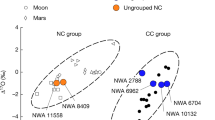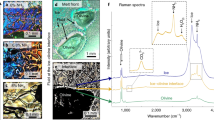Abstract
In the earliest stage of planetary-body formation, a proto-planet presumably consists of loosely-accumulated solid grains, or clusters of grains, with ice mantles and water-ice grains. Physical and chemical reactions, similar to diagenesis1 in the terrestrial permafrost2, may occur and may be enhanced by an interfacial water layer between solid grains and water-ice at temperatures below the melting point of water-ice. The thickness of the inter-facial water layer increases with rising temperature and/or pressure in the proto-planetary body. The model I propose here eases the thermal constraints imposed by earlier models3,4 of low-temperature aqueous alteration in primitive extraterrestrial materials in which formation of an aqueous medium promoting these alterations required complete melting of the water-ice. In the proto-planetary body, low-temperature alterations, for example, the formation of hydrated silicates, will take place because of the presence of an interfacial water layer.
This is a preview of subscription content, access via your institution
Access options
Subscribe to this journal
Receive 51 print issues and online access
$199.00 per year
only $3.90 per issue
Buy this article
- Purchase on Springer Link
- Instant access to full article PDF
Prices may be subject to local taxes which are calculated during checkout
Similar content being viewed by others
References
Berner, R. A. Early Diagenesis, A Theoretical Approach (Princeton University Press, 1980).
Anderson, D. M. & Morgenstern, N. R. in Permafrost, 257–288 (National Academy of Sciences, Washington D.C., 1973).
DuFresne, E. R. & Anders, E. Geochim. cosmochim. Acta 26, 1085–1114 (1962).
Nozette, S. & Wilkening, L. L. Geochim. cosmochim. Acta 46, 557–563 (1982).
Donn, B. & Sears, G. W. Science 140, 1208–1211 (1963).
Grossman, L. & Larimer, J. W. Rev. Geophys. space Sci. 1, 71–101 (1974).
Stephens, J. R. & Kothari, B. K. Moon Planets 19, 139–152 (1978).
Morfill, G. E. Icarus 53, 41–54 (1983).
Greenberg, R., Wacker, J. F., Hartmann, W. K. & Chapman, C. R. Icarus 35, 1–26 (1978).
Wieneke, B. & Clayton, D. D. in Chondrules and their Origins (ed. King, A.) 284–295 (Lunar and Planetary Institute, Houston, 1983).
Bunch, T. E. & Chang, S. Geochim. cosmochim. Acta 44, 1543–1577 (1980).
Lebofsky, L. A. Astr. J. 85, 573–585 (1980).
Lee, T., Papanastassiou, D. A. & Wasserburg, G. J. Geophys. Res. Lett. 3, 109–112 (1976); Astrophys. J. 211, L107–L110 (1977).
Ugolini, F. C. Antarctica J. 11, 248–249 (1976).
Ugolini, F. C. & Jackson, M.L. in Antarctic Geoscience (ed. Craddock, C.) 1101–1108 (University of Wisconsin Press, Madison, 1982).
Gibson, E. K., Wentworth, S. J. & McKay, D.S. J. geophys. Res. 88 (suppl.), A912–A928 (1983).
Gooding, J. L. Icarus 33, 483–513 (1978).
Berner, R. A. Rev. Mineral. 8, 111–134 (1981).
Anderson, D. M. in Rep. planet. Geol. Prog. (NASA Tech. Mem. 84211) 292–296 (1981).
Hallet, B. Proc. Int. Conf. Permafrost 4, 433–438 (National Academy of Sciences, Washington D.C., 1983).
Gooding, J. L. Lunar Planet. Sci. XV, 308–309 (1984).
Clayton, D. D. Lunar Planet. Sci. XV 168–169 (1984).
Donn, B. Astrophys. Space. Sci. 65, 167–171 (1979).
Nuth, J. A. & Donn, B. J. geophys. Res. 88 (suppl.), A847–A852 (1983).
Brownlee, D.E. in Protostars and Planets (ed. Gehrels, T.) 134–150 (University of Arizona Press, 1978).
Rietmeijer, F. J. M. & Mackinnon, I. D. R. Lunar Planet. Sci. XV, 687–688 (1984).
Tomeoka, K. & Buseck, P. R. Lunar Planet. Sci. XV, 858–859 (1984).
Hudson, B., Flynn, G. J., Fraundorf, P., Hohenberg, C. M. & Shirck, J. Science 211, 383–386 (1981).
Zinner, E., McKeegan, J. D. & Walker, R. M. Nature 305, 119–121 (1983).
Bradley, J. P., Brownlee, D. E. & Veblen, D. R. Nature 301, 473–477 (1983).
Wasson, J.T. Meteorites, Classification and Properties, 316 (Springer, Berlin, 1974).
Fraundorf, P., Brownlee, D. E. & Walker, R. M. in Comets (ed. Wilkening, L. L.) 383–409 (University of Arizona Press, 1982).
Fraundorf, P. Geochim. cosmochim. Acta 45, 915–943 (1981).
Clayton, R. N. & Mayeda, T. K. Earth planet. Sci. Lett. 67, 151–161 (1984).
Gooding, J. L. Meteoritics 19, (in the press).
Öpik, E. Adv. Astr. Astrophy. 4, 302–336 (1966).
Author information
Authors and Affiliations
Rights and permissions
About this article
Cite this article
Rietmeijer, F. A model for diagenesis in proto-planetary bodies. Nature 313, 293–294 (1985). https://doi.org/10.1038/313293a0
Received:
Accepted:
Issue Date:
DOI: https://doi.org/10.1038/313293a0
This article is cited by
-
Geologically rapid aqueous mineral alteration at subfreezing temperatures in icy worlds
Nature Astronomy (2022)
-
Detection of carbonates in dust shells around evolved stars
Nature (2002)
-
Processing of cometary grains at the nucleus surface
Earth, Moon, and Planets (1996)
-
Processes affecting the composition and structure of silicate grains in cometary nuclei
Earth, Moon, and Planets (1989)
-
Metastable carbon in two chondritic porous interplanetary dust particles
Nature (1987)
Comments
By submitting a comment you agree to abide by our Terms and Community Guidelines. If you find something abusive or that does not comply with our terms or guidelines please flag it as inappropriate.



